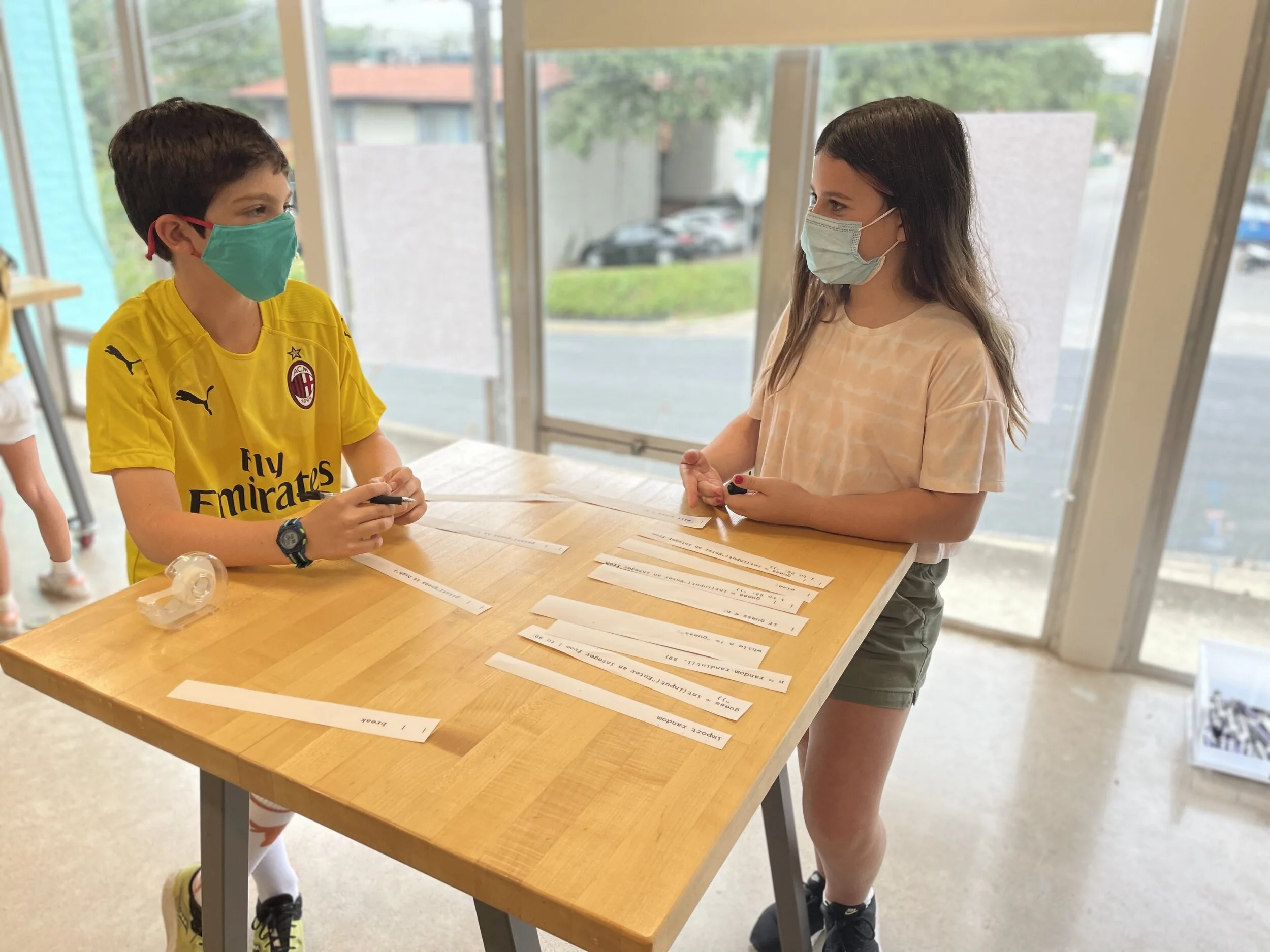Mid-Year Conferences: Taking Stock and Looking Ahead
For the week before Winter Break, no learners whittled in the maker space, scribed on the whiteboards, or curled up with books in the library bean bags, but Long-View was busy nonetheless. The teachers of Long-View devoted the week to analyzing and sharing the work of our learners in mid-year conferences with their families. Along with artifact portfolios, conferences are one of the primary ways we document and communicate how children at Long-View learn.
Throughout the year, Long-View teachers study learners to understand their progress and guide instruction. We think hard, and often collaboratively, about their work. We pay attention to daily behaviors and interactions, and often document particular moments and written products through photos and videos. These digital documents, and the written products themselves, are what we call artifacts of learning….
Read More
From Concept to Process: Teaching the Nature of Science
How do you prevent misunderstandings at a school like Long-View, where learning is student-directed? Under what circumstances does a teacher provide the "right answer," especially in the science classroom? Moreover, what constitutes scientific consensus? According to who? What does it mean to be "right"? Concern about the right answer belies a common misconception about science education—a misconception resulting from faulty science education—premised on the understanding of science as a body of settled knowledge.
Recent developments in science education reflect a shift in emphasis from science as a body of knowledge to a broader view of science that addresses the nature of scientific knowledge itself and the skills required to access and evaluate media accounts of science. In short, the goals of science education have shifted from scientific knowledge to science literacy—the scope of practice in the field of science has broadened from "how the scientific community produces science information, [to] how media repackage and share the information, and how individuals encounter and form opinions on this information….”
Read More
Build Week 12: Bridges and Failure Modeling
Build Week 12 occurred last week and was a great example of the rich opportunities that lie within the challenge of a Build Week. The focus this time was on bridges and understanding the idea of “failure modeling.” The learners were placed in 3 person teams and given a Call to Action for a bridge prototype. Here’s one team’s Call to Action:
DEVELOP, DESIGN, AND CONSTRUCT A PROTOTYPE FOR A LONG-SPAN BRIDGE
Introduction: Your team’s goal is to design a prototype for a long-span traffic bridge to cross a one-mile-wide strait connecting a bay to an ocean. Your team is in competition. On Thursday, October 28th, your prototype will be tested for its strength to weight ratio. During this time, your team will also have to defend your engineering and structural choices and account for any future changes that have become evidently necessary through the failure modeling Research and Design process. Your prototype should be designed to carry approximately 100,000 vehicles/day. Your team should aim to both design and build the lightest and strongest prototype….
Read More
When Reading Level and Maturity Level Don’t Align: How We Think About Our Young, Advanced Readers
Let’s say you’re in fifth grade. You’ve already read all the Harry Potter books three times (okay, you’ve read the first one seven times). You know the entire Percy Jackson series by heart. Your start-of-year reading assessment vaulted you comfortably from level Z to level Z+ on the Fountas and Pinnell reading scale, so you’re now clocking in at a high school reading level, and you keep hearing that you need to read more advanced books. Your older sister (who’s also a Z+ reader) and all her friends are raving about a new young-adult masterpiece that’s won all kinds of awards, but the characters are juniors in high school and they do stuff at a party in the very first chapter that makes you want to drop the book and go straight back to Harry Potter. Where do you turn?
This is a challenge we encounter all the time. At Long-View, 78% of our learners are reading at the Z+ level; this indicates a high school level in terms of both literal and inferential comprehension….
Read More
Frontloading Computational Thinking in the Long-View CS Block
For those who have limited experience in the modern Computer Science domain, it is easy to make the assumption that it is all about learning the syntax and semantics of specific programming languages. However, over a century before the first computer was successfully built, mathematicians Ada Lovelace and Charles Babbage worked to tackle complex problems crucial to Computer Science. At Long-View we like to think of coding as just one tool we use to study the science of computing and instead of planning our learning around programming-specific skills, we ensure the learners are getting the most out of their two hour weekly instruction by focusing on a problem-solving process known as “computational thinking.”
Jeanette Wing first brought this process to the forefront of computer science pedagogy in her 2006 article in Communications of the ACM. Since then, many CS programs in both the k-12 and higher education spaces have adapted their curriculum to frontload concepts and practices promoted under the umbrella of computational thinking….
Read More
Campfire at Long-View
Just before 9:00, when it is time for the day to begin, the sound of the singing bowl fills the main hallway. This low hum alerts that it’s time to begin Campfire and everyone quickly begins to tidy up from the before school projects, workshops, and other happenings, and check the Campfire calendar to choose which of the three discussions to join. Campfire topics and ideas are ignited in a variety of ways. They could be centered around a current event, a personal passion, a historical figure, a question sparked from a podcast, a desire to analyze an intriguing graph, an interesting NPR article, or wonderings about a science investigation….
Read More
History Club Provides Opportunity for Authentic Investment
“What’s the difference between ideology and belief?” Eva asks. It’s 8:30 on a Wednesday morning, and thirty learners have arrived at Long-View an hour before the start of their first block to engage in civic discourse about civics. Welcome to History Club. Invigorated by the return to in-person meetings this fall, the cohort of historically minded fourth through eighth graders has grown and elected to tackle some pretty complex subject matter: the evolution of political thought and government structures. During this meeting, the second of the year, learners examine an extensive list of governmental forms and consider the sources, ideologies, and organizing principles of political power….
Read More
Curating a Diverse Library for Our Learners
Here at Long-View, the members of the Literacy team tend to moonlight as librarians. Whether during the school year on Thursday afternoons, early in the morning, or during the summer months, we are constantly expanding, curating, organizing, and pondering the Long-View library collection. In recent years, Long-View has particularly committed itself to enriching the diversity of the books we offer our learners. While the push for more diverse books—especially for children and teenagers—has become a major initiative across the education and publishing worlds in the United States only relatively recently, it’s much more than a fashionable trend. And it’s much more than an empty gesture towards inclusivity….
Read More
Back to School, Back to (Almost) Normal
Today marked the beginning of the 2021-22 school year, and we are all excited to be back together! Typically the summer gives us all a chance to rest and ready ourselves for the year ahead, but this wasn’t exactly the case this summer. After all the changes that encompassed the 2020-21 school year due to the pandemic, we weren’t quite ready to go our separate ways at the end of May. Things were finally running more smoothly, and we were enjoying all being back in person together after many days of a mix of virtual and in-person learning. Still, summer came and we welcomed the warm weather, but when the calendar turned to August, we were thrilled to be back at school.
It’s Long-View’s 7th year, and we plan to make it the best ever….
Read More
Long-View Teachers Travel to North Carolina to Support School District's Math Teachers
One of the interesting things about Long-View Micro School is the financial model. Our financial model stands apart from the financial models of most independent schools in which tuition is set to cover about 90% of costs, and then funds are raised to manage the “gap.” In the typical independent school, dollars are raised from within the parent community through the annual fund and a gala or other social event. For the most part, it is expected that parents contribute to both of these events, and thus the true cost of attending the schools exceeds tuition. The annual fund and the gala occur during the fiscal year and thus there is significant pressure to raise funds from these events because the budget assumes these dollars will be procured. The dollars must come in lest the school end up in a difficult situation by Q3 or Q4.
At Long-View, we do not depend on fundraising to fund the gap between tuition and operating costs, and the gap is strategically tighter than in most schools….
Read More











